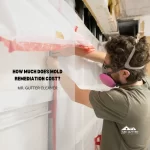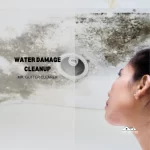Heavy rain often exposes vulnerabilities in a roof, leading to leaks that can cause significant damage to a home. These leaks commonly result from compromised areas such as worn shingles, faulty flashing, or clogged gutters.
Regular maintenance is crucial to identifying and addressing these issues before they escalate during storms.
For homeowners, understanding the underlying causes of roof leaks is the first step towards prevention.
This involves recognizing signs of wear and tear, ensuring gutters and downspouts are clear of debris, and conducting periodic inspections to spot potential problems.
Addressing these issues promptly can prevent water from penetrating the home, safeguarding the structure and interior from moisture-related damage.
With the right knowledge and proactive measures, homeowners can enhance their roof’s resilience against heavy rain, ultimately protecting their investment and maintaining a safe, dry living environment.
What Causes Roof Leaks?
Heavy rains challenge roofs by exposing any weaknesses in their structure, leading to leaks. These leaks often result from a combination of factors that compromise the roof’s integrity.
How Do Heavy Rains Impact Your Roof?
Heavy rains increase water volume and pressure on the roof, highlighting any existing vulnerabilities. This can accelerate wear and tear, making previously minor issues critical. For instance, saturated roofing materials can fail, and water can exploit any gap or weakness.
Identifying Common Vulnerable Areas
Certain areas on a roof are more prone to leaking, especially under the strain of heavy rain.
The Role of Flashing in Waterproofing
Flashing, metal strips installed at roof joints, is critical for directing water away from vulnerable areas. If damaged or improperly installed, flashing can lead to water intrusion and leaks.
Shingles and Tiles: First Line of Defense
Shingles and tiles act as the primary barrier against rain. When they are cracked, loose, or missing, water easily penetrates the underlying layers, leading to leaks.
Gutters and Downspouts: Ensuring Proper Water Flow
Gutters and downspouts play a vital role in managing rainwater flow around a roof. Clogs or damage can cause water to pool, increasing the risk of leaks.
Preventative Measures for Roof Leaks
Taking proactive steps can significantly reduce the risk of roof leaks during heavy rains.
Regular Maintenance Checks: What to Look For?
Homeowners should regularly inspect their roofs for signs of wear, such as damaged shingles or flashing, and ensure gutters and downspouts are clear of debris.
Professional Inspections: When and Why?
Annual inspections by professionals can catch issues that homeowners may miss. Experts can assess the roof’s condition and recommend necessary repairs to prevent leaks.
Immediate Steps After Identifying Potential Leaks
Upon noticing signs of potential leaks, immediate action is required. Small repairs, like sealing minor cracks or clearing gutters, can prevent significant water damage.
How to Address Existing Leaks
Addressing leaks promptly can prevent further damage and protect the home’s structural integrity.
Temporary Solutions for Immediate Relief
Homeowners can apply temporary fixes like waterproof tape or sealants to stop water ingress. These measures provide immediate relief until professional repairs can be made, minimizing water damage.
Long-Term Repairs: Seeking Professional Help
For a permanent solution, hiring roofing professionals is essential. They can assess the damage, replace faulty materials, and ensure the roof’s overall health, preventing future leaks.
The Importance of Timely Repairs
Delaying repairs can lead to more extensive damage and higher repair costs. Acting quickly after detecting a leak can save homeowners time and money, maintaining the roof’s longevity.
Enhancing Your Roof’s Rain Resistance
Improving a roof’s ability to withstand heavy rain involves several strategic upgrades and adjustments.
Waterproofing Solutions: Beyond the Basics
Beyond standard repairs, applying waterproof coatings and membranes can significantly enhance a roof’s resistance to water, offering an extra layer of protection during heavy rainfall.
Innovative Materials and Technologies
Investing in advanced roofing materials like rubberized shingles or reflective coatings can increase a roof’s durability and efficiency, reducing the likelihood of leaks.
Landscaping and External Factors Affecting Roof Health
Proper landscaping can also play a crucial role in protecting a roof from heavy rains. Trees should be trimmed regularly to prevent branches from damaging the roof during storms, and proper yard drainage can prevent water accumulation around the home’s foundation.
Understanding the Impact of Roof Leaks
The consequences of roof leaks extend beyond mere water intrusion, affecting the home’s structure, health environment, and financial stability.
Structural Damage: What Happens Over Time?
Unaddressed leaks weaken the home’s structure. Water infiltrating wood causes rot, compromising the roof’s integrity and the safety of inhabitants. Continuous exposure to moisture can also damage insulation, leading to increased energy costs.
Health Risks Associated with Dampness and Mold
Moist environments foster mold and mildew growth, posing serious health risks. Respiratory issues, allergies, and other health problems can arise from prolonged exposure to these fungi.
Financial Implications of Neglected Leaks
Ignoring roof leaks can lead to costly repairs. Early intervention prevents minor issues from escalating into major expenses, preserving the home’s value and avoiding unexpected financial burdens.
FAQ: Common Questions About Roof Leaks
Addressing frequently asked questions helps homeowners better understand and manage roof leaks.
Can Small Leaks Cause Significant Damage?
Yes, even minor leaks can lead to significant structural and interior damage over time. Early detection and repair are crucial to prevent widespread damage.
How Often Should Roofs Be Replaced or Repaired?
Roof lifespan varies by material but generally requires inspection and potential repair every few years. Replacement is typically necessary every 20 to 30 years, depending on the roofing material and environmental conditions.
DIY vs. Professional Repairs: What You Need to Know
While minor repairs can be DIY projects, professional services are recommended for significant damage. Experts have the tools, knowledge, and experience to diagnose and effectively address roof leaks.


